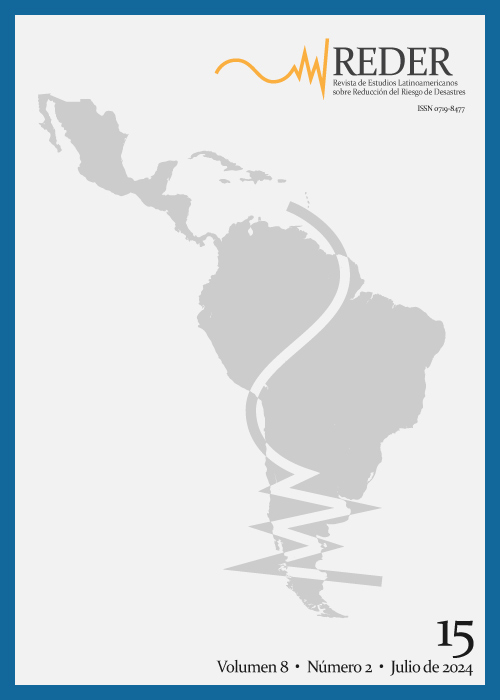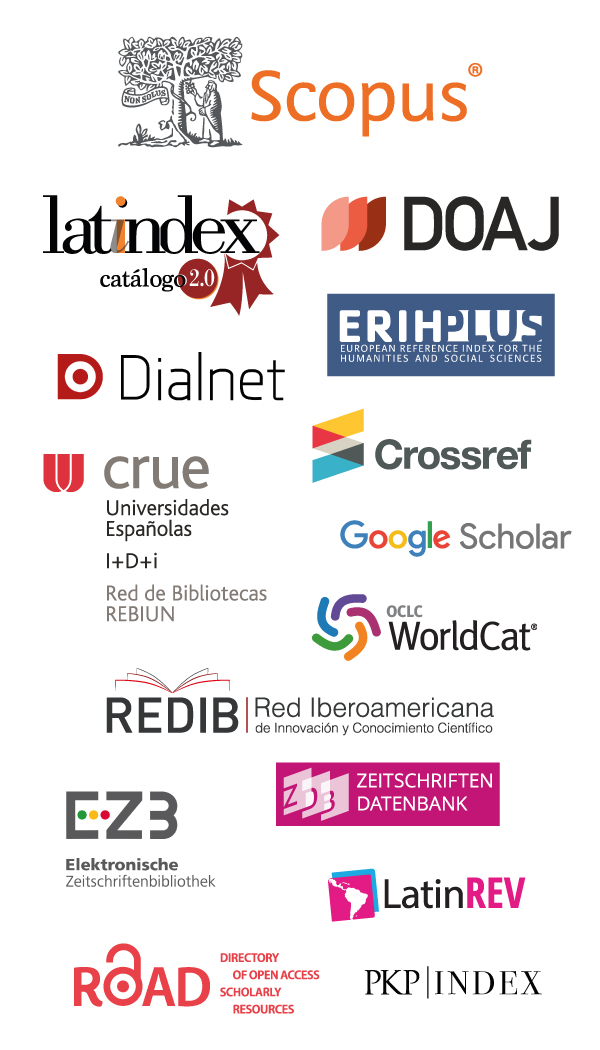Comunicación del Riesgo en Latinoamérica: Una Evaluación de su Impacto frente a la Pandemia del COVID-19
DOI: https://doi.org/10.55467/reder.v6i2.102
Resumen
El escenario de riesgo sistémico generado por la pandemia del COVID-19 obliga a revisar cómo los mecanismos de comunicación del riesgo son capaces de incidir en el comportamiento de las personas y, con ello, fomentar la adhesión a las medidas de autocuidado y de prevención de los contagios. Para evaluarlos, esta investigación analiza el caso de 4 ciudades latinoamericanas, comparando las políticas impulsadas por los gobiernos nacionales y los determinantes de la adherencia. Se establece que la confianza en quien comunica y en los medios de comunicación es un factor gravitante en la adopción de las medidas por parte de la población, así como algunos factores sociodemográficos (edad y nivel educativo). A la vez, muestra que las personas que viven en la ciudad de Buenos Aires han tenido un mayor nivel de cumplimiento que las de Santiago, Lima y Bogotá. La investigación permite concluir que el campo de la comunicación del riesgo en la región requiere una mayor comprensión y desarrollo por parte de los diversos actores involucrados en ella.
Palabras clave
Texto completo:
PDFReferencias
Allen, A., Belkow, T., Escalante Estrada, C., de los Ríos, S., Kamiya, M., Miranda, L., Wesely, J. & Zilbert Soto, L. (2017). De la mitigación de desastres a la interrupción de trampas de riesgo: La experiencia de aprendizaje-acción de cLIMA sin Riesgo. Revista de Estudios Latinoamericanos sobre Reducción del Riesgo de Desastres, 1(1), 6-28. https://doi.org/10.55467/reder.v1i1.2
Beecher, N., Harrison, E., Goldstein, N., McDaniel, M., Field, P., & Susskind, L. (2005). Risk perception, risk communication, and stakeholder involvement for biosolids management and research. Journal of Environmental Quality, 34(1), 122-128.
Brecher, R. W., & Flynn, T. (2002). Principles of risk communication: building trust and credibility with the public. Handbook of toxicologic pathalogy, 1, 447-457.
Bronfman, N.C., Repetto, P.B., Cisternas, P.C., & Castañeda, J.V. (2021). Factors influencing the adoption of COVID-19 preventive behaviors in Chile. Sustainability, 13(10), 5331.
Carvalho, T. (2020). COVID-19 Research in Brief: December 2019 to June, 2020. Nature.
Castro, C.P., Ibarra, I., Lukas, M., Ortiz, J. & Sarmiento, J.P. (2015). Disaster risk construction in the progressive consolidation of informal settlements: Iquique and Puerto Montt (Chile) case studies. International Journal of Disaster Risk Reduction, (13), 109-127.
Covello, V., von Winterfeldt, D., & Slovic, P. (1986) Risk Communication: Background Report for the National Conference on Risk Communication. Conservation Foundation.
Covello, V., von Winterfeldt, D., & Slovic, P. (1987) Communicating Scientific Information About Health and Environmental Risks: Problems and Opportunities from a Social and Behavioral Perspective En Covello, V., Lave, L., Moghissi, A., Virginia, A. & Uppuluri, V. (Eds), Uncertainty in Risk Assessment, Risk Management, and Decision Making. Plenum Press.
Cutter, S.L., Boruff, B.J., & Shirley, W.L. (2003). Social vulnerability to environmental hazards. Social science quarterly, 84(2), 242-261.
Djalante, R., Shaw, R., & DeWit, A. (2020). Building resilience against biological hazards and pandemics: COVID-19 and its implications for the Sendai Framework. Progress in Disaster Science, 6, 100080. https://doi.org/10.1016/j.pdisas.2020.100080
Domingues, J. (2020). Coronavirus, riesgo y cambio social. En Bringel, B., Pleyers, G. (Eds) Alerta Global Políticas, movimientos sociales y futuros en disputa en tiempos de pandemia. CLACSO.
Fernandez, G., & Shaw, R. (2016). Urban disasters and risk communication through youth organizations in the Philippines. En Shaw, R., Rahman, A., Surjan, A. & Parvin, G.A. (Eds.), Urban disasters and resilience in Asia (pp. 195-207). Butterworth-Heinemann.
Guadagno, L. (2020). Migrants and the COVID-19 pandemic: An initial analysis. IOM. https://shar.es/af2GVz
Haesbaert, R. (2016). Las trampas del territorio. En Silva J. et al. (Eds), Territorio: Território: modos de pensar e usar. Ediçoes UFC.
Malecki, K., Keating, J.A., & Safdar, N. (2021). Crisis Communication and Public Perception of COVID-19 Risk in the Era of Social Media. Clinical Infectious Diseases, 72(4), 697–702. https://doi.org/10.1093/cid/ciaa758
Michie, S., West, R., Amlôt, R., & Rubin, J. (2020). Slowing down the covid-19 outbreak: changing behaviour by understanding it. BMJ.
Montes, A. (2020). COVID-19, la España vaciada y el futuro de la política regional. ICEI Papers COVID-19, 24.
Organización Panamericana de la Salud (OPS). (2020). COVID-19, Glosario sobre brotes y epidemias. Un recurso para periodistas y comunicadores. OPS.
Organización Mundial de la Salud (OMS). (2019) Health emergency and disaster risk management framework. OMS.
Organización Mundial de la Salud (OMS). (2020). General information on risk communication. OMS. https://www.who.int/risk-communication/background/en/
Pasman, H. (2015). Risk, Risk Perception, Risk Communication, Risk Acceptance. Risk Analysis and Control for Industrial Processes - Gas, Oil and Chemicals, 431–454.
Pauta (2020). Inmunidad de rebaño: la estrategia que el Gobierno no aplicó, aunque sí la anunció. Pauta [online]. https://www.pauta.cl/nacional/covid-19-especialistas-descartan-chile-haya-optado-por-inmunidad-de-rebano
Renn, O. (2020). New challenges for risk analysis: systemic risks. Journal of Risk Research, 24(1), 1-7. http://doi.org/10.1080/13669877.2020.1779787
Rogers, M.B., & Pearce, J.M. (2013). Risk Communication, Risk Perception and Behavior as Foundations of Effective National Security Practices. En Akhgar, B. & Yates, S. (Eds.), Strategic Intelligence Management: National Security Imperatives and Information and Communications Technologies (pp.66-74). Butterworth-Heinemann https://doi.org/10.1016/B978-0-12-407191-9.00006-5
Rosa, E., McCright, A., & Renn, O. (2013). The Three Companions of Risk: Complexity, Uncertainty, and Ambiguity. En Rosa, E., McCright, A., & Renn, O (Eds.), The Risk Society Revisited: Social Theory and Risk Governance (pp.130-149). Temple University Press.
Slovic, P. (1987), Perception of risk. Science, 236(4799), 280-285.
Solinska-Nowak, A., Magnuszewski, P., Curl, M., French, A., Keating, A., Mochizuki, J., ... & Jarzabek, L. (2018). An overview of serious games for disaster risk management–Prospects and limitations for informing actions to arrest increasing risk. International journal of disaster risk reduction, 31, 1013-1029.
United Nations Office for Disaster Risk Reduction (UNDRR). (2017, 2 de febrero). Online glossary. Terminology. UNDRR [online]. https://www.undrr.org/terminology
United Nations International Strategy for Disaster Reduction (UNISDR). (2005). Hyogo Framework for Action 2005-2015: Building the resilience of nations and communities to disasters. UNISDR.
United Nations International Strategy for Disaster Reduction (UNISDR). (2015). Sendai Framework for Disaster Risk Reduction 2015-2030. UNISDR.
West, R., Michie, S., Rubin, G.J., & Amlôt, R. (2020). Applying principles of behaviour change to reduce SARS-CoV-2 transmission. Nature Human Behaviour, 4(5), 451-459.
Wilder-Smith, A., Chiew, C.J., & Lee, V.J. (2020). Can we contain the COVID-19 outbreak with the same measures as for SARS?. The lancet Infectious Diseases, 20(5), e102-e107.
Yakymchuk, I.P., Olkhovetskyi, S.M., Rashkovska, I.V., Bevz, H.M., & Martseniuk, M.O. (2021). Experiencing and overcoming financial stress in married couples: A study in COVID 19 pandemic era. Revista Amazonia Investiga, 10(42), 124-140.
Zakaria, N., & Mustaffa, C.S. (2014). Source credibility, risk communication and well-being: A conceptual framework. Procedia-Social and Behavioral Sciences, 155, 178-183.
Enlaces refback
- No hay ningún enlace refback.








